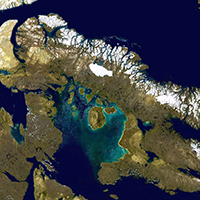Physical and chemical characteristics of 1300 lakes and ponds across the Canadian Arctic
Characteristics of Canadian Arctic lakes and ponds

Accepted: 25 August 2020
Supplementary: 107
HTML: 255
All claims expressed in this article are solely those of the authors and do not necessarily represent those of their affiliated organizations, or those of the publisher, the editors and the reviewers. Any product that may be evaluated in this article or claim that may be made by its manufacturer is not guaranteed or endorsed by the publisher.
Authors
Lakes and ponds are a major feature of the Arctic landscape and are recognized as effective ‘sentinels of change’. Here we present water chemistry characteristics of lakes and ponds (n=1300 with 26 variables) across the Canadian Arctic collated from published studies. We also extracted geological and ecoregion data in an attempt to determine the key drivers. In general, most lakes were shallow (85.4%, <10 m), nutrient (phosphorus) poor (oligotrophic = 45.6% and ultra-oligotrophic = 24.8%), located at low elevation (66.5%, <200 m asl), close to coastlines (72.5%, 0-50 km), and underlain by sedimentary geology (66.5%). The first two components from Principal Component Analysis explained 49.3% of the variation in the dataset; the first component was dominated by conductivity/carbonate materials, and the second component suggested allochthonous inputs of phosphorus. In general, bedrock geology is the primary driver of water chemistry; as such, there were major differences between lakes underlain by igneous and sedimentary rocks. Those on sedimentary bedrock tend to have higher pH, nutrients and higher inorganic ion concentrations.
Edited by
Michela Rogora, CNR-IRSA Verbania, ItalyHow to Cite
Similar Articles
- Alec R. Lackmann, Malcolm G. Butler, Breaking the rule: Five larval instars in the podonomine midge Trichotanypus alaskensis Brundin from Barrow, Alaska , Journal of Limnology: Vol. 77 No. s1 (2018): Recent advances in the study of Chironomidae: An overview
- Andrey Przhiboro, Abdusattor Saidov, Ninel Petrova, Firuz Akhrorov (1937-2012) and his contributions to the study of Chironomidae in Tajikistan , Journal of Limnology: Vol. 77 No. s1 (2018): Recent advances in the study of Chironomidae: An overview
- Claudio A. BELIS, Daniel ARIZTEGUI, The influence of biological and environmental factors on the stable isotopic composition of ostracods – the Late Pleistocene record from Lake Albano, Central Italy , Journal of Limnology: Vol. 63 No. 2 (2004)
- John T. LEHMAN, "We learned how to live in Pallanza" , Journal of Limnology: Vol. 59 No. 1 (2000)
- Giovanni Pilato, Lorena Rebecchi, Introduction to the Proceedings , Journal of Limnology: Vol. 66 No. s1 (2007): 10th International Symposium on Tardigrada
- A. Lami, N. Cameron, A. Korhola, Preface , Journal of Limnology: Vol. 59 No. s1 (2000): Climatic variability and ecosystem dynamics at remote mountain lakes
- Carla BONACINA, Andrea PASTERIS, Zooplankton of Lake Orta after liming: an eleven years study , Journal of Limnology: Vol. 60 No. 1 (2001)
- Paola M.A. DECRISTOPHORIS, Sandro PEDUZZI, Nadia RUGGERI-BERNARDI, Dittmar HAHN, Mauro TONOLLA, Fine scale analysis of shifts in bacterial community structure in the chemocline of meromictic Lake Cadagno, Switzerland , Journal of Limnology: Vol. 68 No. 1 (2009)
- Silvana GALASSI, Pietro VOLTA, Alcide CALDERONI, Licia GUZZELLA, Cycling pp'DDT and pp'DDE at a watershed scale: the case of Lago Maggiore (Italy) , Journal of Limnology: Vol. 65 No. 2 (2006)
- Guia CECCHINI, Stefano CARNICELLI, Aldo MIRABELLA, Francesco MANTELLI, Guido SANESI, Soil conditions under a Fagus sylvatica CONECOFOR stand in Central Italy: an integrated assessment through combined solid phase and solution studies , Journal of Limnology: Vol. 61 No. s1 (2002): National Programme for Forest Ecosystems Control CONECOFOR
<< < 81 82 83 84 85 86 87 88 89 90 > >>
You may also start an advanced similarity search for this article.
-
Jonathan B. Martin, Andrea J. Pain, Ellen E. Martin
-
Zhizhong Li, Madjid Hadioui, Kevin J. WilkinsonNanomaterials : 2023

 https://doi.org/10.4081/jlimnol.2020.1973
https://doi.org/10.4081/jlimnol.2020.1973





